Difference between revisions of "Orthotrichum bolanderi"
Icon. Musc., suppl., 64, plate 46. 1874.
FNA>Volume Importer |
FNA>Volume Importer |
(No difference)
| |
Revision as of 19:46, 24 September 2019
Plants 0.5–4 cm, dark green to black. Stem leaves stiff, erect-appressed, rarely incurved when dry, lanceolate, 2–3.5 mm; margins plane, entire; apex narrowly obtuse to acute; basal laminal cells elongate, walls thick, ± nodose; distal cells 7–11 µm, 2-stratose, papillae 2–4 per cell, conic, sometimes large. Specialized asexual reproduction absent. Sexual condition gonioautoicous. Seta 1 mm. Capsule emergent, ovate-oblong when mature, ovate-cylindric when old, 1.4–2 mm, slightly 8-ribbed in distal 1/3 of capsule; stomata superficial; peristome double; prostome present, rudimentary; exostome teeth 8, erect, sometimes reflexed when old and dry, papillose to coarsely papillose-striate; endostome segments 8, occasionally rudimentary, of 2 rows of cells, papillose. Calyptra oblong-conic, smooth, hairy, hairs papillose. Spores 17–23 µm.
Habitat: Rock, especially sandstone
Elevation: low to high elevation (100-2000 m)
Distribution

Calif., Wash., Mexico, Central America (Guatemala).
Discussion
Orthotrichum bolanderi is the only species with superficial stomata that has 2-stratose distal laminal cells. The plants have leaves with subsheathing bases, ovoid-cylindric capsules with long wrinkled necks, and reflexed-recurved exostome teeth. When dry, the leaves are stiffly erect-appressed; they lie flat on a microscope slide when wet.
Selected References
None.